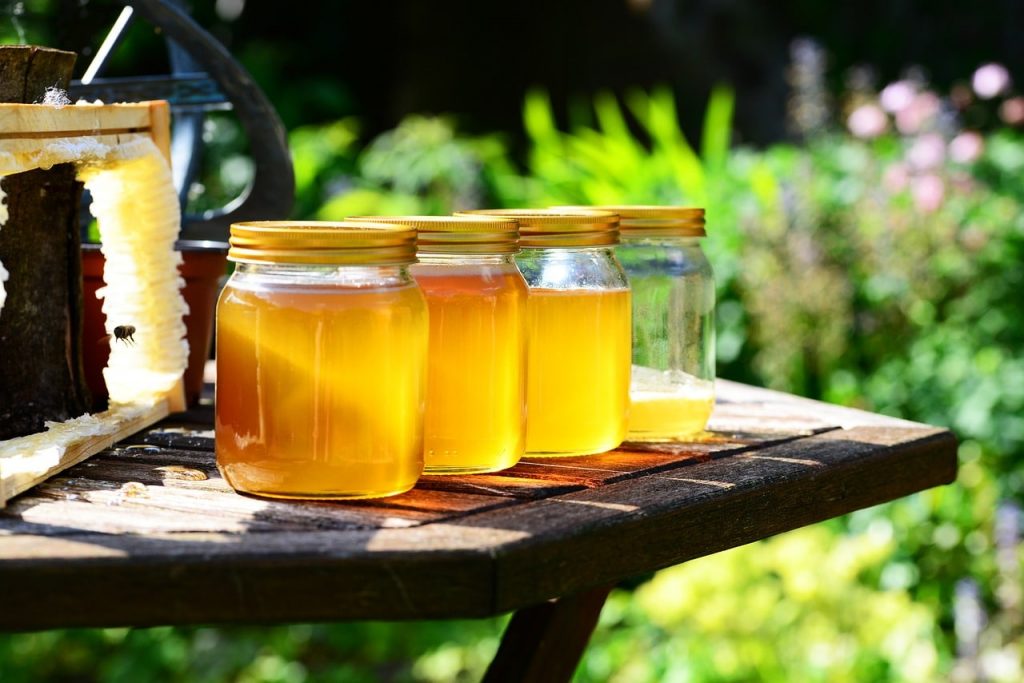
Is honey really all that it’s cracked up to be? And, even if it is, should you be eating it if you have gout? Here you’ll discover the potential dangers of adding this sweet golden liquid, made by honey bees, into your gout diet.
Honey and Gout
Before we consider how honey reacts with gout, let’s just take a second to remind ourselves of what causes gout…
Gout
The root cause of gout is abnormally high levels of uric acid in the bloodstream, a condition called hyperuricemia.
Needle-like crystals of monosodium urate can precipitate out of the uric acid over time and become lodged in the joints and associated tissue.
The body defends itself against these “invaders” by flooding the area with white blood cells and inflammatory mediators. This innate inflammatory response gives rise to the typical symptoms of a gout attack: swelling, inflammation, shiny-looking red skin, hot to the touch, stiffness, and great pain.
So where does uric acid come from?…
Uric Acid and Purines
Uric acid is a byproduct of the breakdown of natural compounds, found in our body’s cells, called purines. Purines also exist in the food we eat, both animal and plant, which food may contribute as much as thirty percent of our uric acid load.
Uric Acid and Fructose
Fructose is a simple sugar found in many plants. But, although fructose isn’t a purine, it too has been associated with raised blood uric acid levels, since it helps to increase purine metabolism.
Fructose is found in table sugar and a whole array of processed foods and drinks, often in the form of High Fructose Corn Syrup (HFCS), which is manufactured from corn starch.
And don’t forget that too much sugar causes weight gain. This is important to bear in mind because being overweight is one of the highest risk factors for gout.
So, not only does too much sugar increase your risk of gout through increased uric acid, it also increases it through weight gain.
You can see why the purine and fructose in your diet are important considerations for effective gout management.
Now let’s take a look at honey…
Honey
Honey is a sweet, thick, golden liquid made by honey bees from the nectar of flowers and stored in honeycombs. Taste, smell, color, and texture are determined by the types of flowers the bees take the nectar from.
There are over three hundred varieties of honey, some of the most popular being:
- clover
- leatherwood
- manuka
- tupelo
- buckwheat
- eucalyptus
- sage
- sourwood
- heather
- orange blossom
- acacia
Health Benefits of Honey
Honey has been used for thousands of years for its curative and healing purposes, including on wounds and burns.
Honey has natural antibacterial and antimicrobial properties that have been so well researched that medical-grade honey is used today to treat certain types of wounds (including surgical wounds), severe burns, and problematic leg and foot ulcers.
And at least one trial concluded that raw honey can help chronic seborrheic dermatitis on the scalp, face, and chest.
Honey also contains powerful antioxidants, such as phenolic acids and flavonoids, that help to prevent oxidative cell damage caused by free radicals in the body. Oxidative stress can lead to some serious diseases, such as heart disease, stroke, diabetes, arthritis, emphysema, asthma, and even some cancers. Studies have shown that honey — particularly buckwheat types — can help to increase antioxidant activity in the blood so that honey may protect against these conditions.
Several studies have even linked honey to improved cholesterol, lowered triglycerides levels in the blood, and reduced blood pressure.
There’s also some evidence that honey may be beneficial in suppressing coughs and relieving sore throats.
On the face of it, then, honey seems to have a lot going for it healthwise.
Unfortunately, it’s not all good news…
Honey is High in Sugar and Calories
Raw honey is made up of approximately 30% glucose, 40% fructose, and may also contain low levels of sucrose and/or maltose. The rest is made up of water, bee pollen, propolis, and trace amounts of vitamins, such as some B vitamins and vitamin C as well as minerals, such as calcium, magnesium, potassium, selenium, manganese and iron.
Contrast that with refined sugar which consists of 50% glucose and 50% fructose. So honey isn’t all that far behind in terms of its sugar content although it does have the nutritional benefits — albeit in very minute amounts — that are missing in refined sugar.
It’s also high in calories: a tablespoon of honey has 64 calories, according to the US Department of Agriculture (USDA) National Nutrient Database.
So, although it’s more nutritious than refined sugar, it still needs to be consumed in moderation due to its high sugar and calorie content, which can be injurious to your health.
The best way to use honey is to replace all other forms of external sugar and sweeteners with it. For example, use it instead of sugar on your cereal; instead of jam in yogurt or on your bread and toast; and in any beverages you would normally add sugar to.
But is it okay to include honey in your gout diet even in moderation?…
Can You Eat Honey with Gout?
Let’s look at honey’s purine and sugar content…
Purines in Honey
Honey is a very low purine food producing just 1.1 mg of uric acid per 100 g serving when consumed. Source: J-STAGE Biological and Pharmaceutical Bulletin
So, as far as its purine content goes, honey should be safe in a gout diet.
But the same can’t be said about its fructose content…
Sugar in Honey
There’s no escaping that fact that honey is high in sugar, especially fructose. You saw earlier that fructose helps to increase purine metabolism that then leads to increased uric acid — the root cause of gout.
And, since its high in total sugars and calories, consuming too much honey can lead to weight gain, even with regular exercise. Studies have shown that being overweight is a key risk factor for gout.
So, although it’s very low in purines, honey’s high sugar and calorie content makes it problematic for us gout sufferers, unless it’s consumed in moderation.
The bottom line is this: if you like honey then add it into your gout diet, sure, but only sparingly (no more than 12 grams a day) and ditch all your other unhealthy sugars and sweeteners. Source: Maes Honey
But not all honeys are created equal…
What Type of Honey is Best?
At least one piece of research suggests that dark raw honey contains more antioxidants than light honey.
And, unlike regular honey, raw honey from the honeycomb isn’t pasteurized, so it retains all of its health-giving antioxidants, enzymes, vitamins and minerals.
Regular honey goes through a pasteurizing and filtering process to help improve it’s appearance and increase shelf-life. This process strips away nearly all of its health benefits.
Not only that, regular honey may even contain additives such as glucose and high fructose corn syrup (particularly bad for gout). This is especially true of cheaper brands.
In addition, raw honey has a lower Glycemic Index (GI) than processed honey: ranging between 35 and 58 on the GI scale, depending on the type of honey.
So stick to high-quality dark raw honey. But only eat it in moderation to ensure you strike the right balance between its health benefits and the risk of gout due to its high fructose content.
Here’s a great little video that explains what raw honey is (and is not)…
Who Should Not Eat Raw Honey
Children under the age of 1 year shouldn’t be given raw honey due to the (rare) risk of infant botulism which is caused by toxins from the bacteria Clostridium botulinum. After this age children’s digestive systems have usually developed enough to combat such toxins.
And, since raw honey isn’t pasteurized, those with a compromised immune systems and pregnant women should also avoid it.
It goes without saying that those with an allergy to honey should avoid it completely.
Final Word: Raw Honey is Still Sugar!
Honey is just a less harmful form of sugar than refined sugar. And its nutrients are present in such minute quantities that you’d need to consume a lot of it to get any real benefit.
In any case, all of honey’s nutrients can be found — often in greater concentrations — in everyday foods, such as:
- leafy green vegetables
- fresh and dried fruit
- nuts
- seeds
- wholegrains
- eggs
- natural yogurt
- low-fat cheese and milk
In other words, honey isn’t essential in a well-balanced gout diet.
IMHO honey’s only real benefit for someone with gout is as a replacement for refined sugar and other unhealthy sweeteners.



